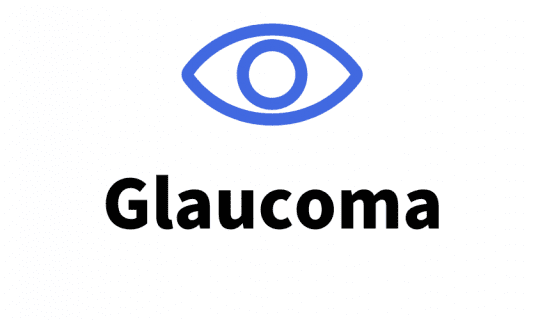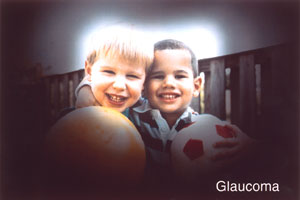Glaucoma

What is Glaucoma?
There are various categories, but broadly Glaucoma is a common condition which occurs when the optic nerve is damaged due to increased pressure inside of the eye caused by a build-up of fluid in the front part of the eye. The optic nerve connects the eye to the brain so it is essential for sight. The condition is more common in adults in their 70s and 80s but can affect all age groups. It can cause sight loss and eventual blindness if not diagnosed and treated early.
The most common type is ‘primary open angle glaucoma’ which usually develops slowly over many years and is caused by the drainage channels in the eye gradually becoming clogged.
‘Acute angle closure glaucoma’ is an uncommon type caused by the drainage in the eye becoming suddenly blocked. This can increase eye pressure very quickly.
Secondary glaucoma is caused by another underlying eye condition such as Uveitis which causes inflammation of the eye (see the relevant section further down).
Congenital glaucoma is a rare type that occurs in very young children and is caused by an abnormality in the eye. This condition currently has no known cure though it can be managed.
Symptoms of Glaucoma:
Generally symptoms are not present early on. It tends to develop slowly over many years and begins by first affecting the edges of peripheral vision. So many people may not realise they have Glaucoma and it can be picked up at a routine eye test instead. If symptoms are noticed early on, they may include blurred vision and seeing rainbow coloured circles around bright lights. Both eyes can be affected but the condition may be worse in one eye.
In very occasional cases where Glaucoma develops suddenly, symptoms may include;
Intense eye pain, nausea and vomiting, red eye, headache, tenderness around the eyes, seeing rings around lights and blurred vision.
If symptoms develop suddenly, it is considered a medical emergency so you should attend your local eye casualty unit or A&E as soon as possible.

Scene as someone fully sighted would see it.

Scene as someone with Glaucoma would see it.
How is Glaucoma diagnosed:
Various healthcare organisations like the NHS recommend attending eye tests at least once every two years at your local opticians. Those at higher risk (see risk factors below) should attend more often.
Examinations that measure vision (especially peripheral vision), pressure levels in the eyes, optic nerve health, and assess fluid drainage patterns in the eye are the most conducive in detecting Glaucoma and determining which type is present (often before any noticeable symptoms have occurred). If the relevant signs are found by the optometrist, then you should be referred to an eye specialist doctor (ophthalmologist) to discuss treatment / management. The NHS website provides a detailed breakdown of the various individual eye tests.
Treatments for / management of Glaucoma:
The type and extent of treatment and its level of effectiveness is dependent on the type of Glaucoma and to what extent the condition has already impacted the persons sight before the treatment begins. So, treatment / management may be short term, long term or lifelong. Note that any sight loss that has already occurred before treatment begins generally can’t be reversed. However treatment can stop your sight from deteriorating further.
Typical treatments / management procedures include;
- Eye drops specifically for lowering eye pressure
- Laser treatment to open blocked drainage tubes or to reduce fluid production in the eyes (usually used if eye drops alone are not sufficient)
- Surgery to improve the drainage of fluid (normally resorted to when neither laser treatment nor eye drops have been sufficient)
- You will most likely also require routine appointments to monitor the condition and effectiveness of treatment(s)
It is essential to strictly commit to any prescribed daily eye drops or you’re sight may be negatively impacted. Note, for some people eye drops may cause side effects like irritation . Some eye drops are not suitable for people with specific conditions. However, there are a wide variety of eye drops that can be used for the same purpose, so be sure to report any side effects immediately so that they can make a swift transition to alternative medication. Also, it is recommended to gently press on the inside corner of the eye (over the eyelid) after administering an eye drop as this can reduce side effects and increase the effectiveness of treatment.
Surgeries may entail; removing part of the drainage tubes, removing part of the white outer covering of the eye ball (the sclera), widening the drainage tubes in the eye (sometimes by placing a device inside), or placing an artificial tube into the eye to increase fluid drainage. Depending on the type of surgery and the circumstances of your condition, you may or may not need to take eye drops after the procedure(s). After surgery you may experience redness in the eye which may also be watery. You may also have slightly blurred vision for up to six weeks. Peoole are generally advised to avoid strenuous activities such as heavy lifting, bending, driving, reading, and the like for at least a week after surgery. As well as keeping the eye dry. Your ophthalmologist will advise on the specifics regarding the above or anything else relevant to the recovery phase.
Prevention / risk factors:
While it has been established that in most cases the condition is caused by increased pressure due to fluid not being drained properly, the reason why this occurs is still unknown. However some identified related risk factors include;
- Age (more common as you get older)
- Being of African, Caribbean, or Asian origin
- Family history of having the condition
- Having other medical conditions like long sightedness, short sightedness, and diabetes
Research into prevention methods is still ongoing and it is not currently clear what / if anything can be done to avoid Glaucoma. Aside from perhaps managing / preventing other related medical conditions to potentially reduce risk level. However as mentioned, having regular eye tests can help pick it up as early as possible which increases the likelihood of more effective treatment.
Further information and Support:
Glaucoma RNIB:
https://www.rnib.org.uk/your-eyes/eye-conditions-az/glaucoma/
International glaucoma Association:
Free NHS eye tests eligibility:
https://www.nhs.uk/nhs-services/opticians/free-nhs-eye-tests-and-optical-vouchers/
